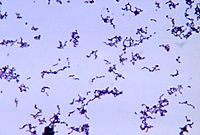
Photo from wikipedia
Purpose: To investigate the composition and diversity of the microbiota on the ocular surface of patients with blepharitis in northwestern China via 16S rDNA amplicon sequencing. Methods: Thirty-seven patients with… Click to show full abstract
Purpose: To investigate the composition and diversity of the microbiota on the ocular surface of patients with blepharitis in northwestern China via 16S rDNA amplicon sequencing. Methods: Thirty-seven patients with blepharitis divided into groups of anterior, posterior and mixed blepharitis and twenty healthy controls from northwestern China were enrolled in the study. Samples were collected from the eyelid margin and conjunctival sac of each participant. The V3–V4 region of bacterial 16S rDNA in each sample was amplified and sequenced on the Illumina HiSeq 2500 sequencing platform, and the differences in taxonomy and diversity among different groups were compared. Results: The composition of the ocular surface microbiota of patients with blepharitis was similar to that of healthy subjects, but there were differences in the relative abundance of each bacterium. At the phylum level, the abundances of Actinobacteria, Cyanobacteria, Verrucomicrobia, Acidobacteria, Chloroflexi, and Atribacteria were significantly higher in the blepharitis group than in the healthy control group, while the relative abundance of Firmicutes was significantly lower (p < 0.05, Mann-Whitney U). At the genus level, the abundances of Lactobacillus, Ralstonia, Bacteroides, Akkermansia, Bifidobacterium, Escherichia-Shigella, Faecalibacterium, and Brevibacterium were significantly higher in the blepharitis group than in the healthy control group, while the relative abundances of Bacillus, Staphylococcus, Streptococcus, and Acinetobacter were significantly lower in the blepharitis group (p < 0.05, Mann-Whitney U). The microbiota of anterior blepharitis was similar to that of mixed blepharitis but different from that of posterior blepharitis. Lactobacillus and Bifidobacterium are biomarkers of posterior blepharitis, and Ralstonia is a biomarker of mixed blepharitis. There was no significant difference in the ocular surface microbiota between the eyelid margin and conjunctival sac with or without blepharitis. Conclusion: The ocular surface microbiota of patients with blepharitis varied among different study groups, according to 16S rDNA amplicon sequencing analysis. The reason might be due to the participants being from different environments and having different lifestyles. Lactobacillus, Bifidobacterium, Akkermansia, Ralstonia, and Bacteroides may play important roles in the pathogenesis of blepharitis.
Journal Title: Frontiers in Medicine
Year Published: 2021
Link to full text (if available)
Share on Social Media: Sign Up to like & get
recommendations!